+ Open data
Open data
- Basic information
Basic information
| Entry | Database: PDB / ID: 8jhi | ||||||
|---|---|---|---|---|---|---|---|
| Title | FZD3-Gs complex | ||||||
 Components Components |
| ||||||
 Keywords Keywords |  MEMBRANE PROTEIN / FZD3 / MEMBRANE PROTEIN / FZD3 /  Complex Complex | ||||||
| Function / homology |  Function and homology information Function and homology informationdopaminergic neuron axon guidance / serotonergic neuron axon guidance /  cell proliferation in midbrain / establishment of planar polarity / negative regulation of mitotic cell cycle, embryonic / cell proliferation in midbrain / establishment of planar polarity / negative regulation of mitotic cell cycle, embryonic /  Wnt receptor activity / midbrain morphogenesis / non-canonical Wnt signaling pathway / motor neuron migration / sympathetic ganglion development ...dopaminergic neuron axon guidance / serotonergic neuron axon guidance / Wnt receptor activity / midbrain morphogenesis / non-canonical Wnt signaling pathway / motor neuron migration / sympathetic ganglion development ...dopaminergic neuron axon guidance / serotonergic neuron axon guidance /  cell proliferation in midbrain / establishment of planar polarity / negative regulation of mitotic cell cycle, embryonic / cell proliferation in midbrain / establishment of planar polarity / negative regulation of mitotic cell cycle, embryonic /  Wnt receptor activity / midbrain morphogenesis / non-canonical Wnt signaling pathway / motor neuron migration / sympathetic ganglion development / sensory perception of chemical stimulus / filopodium tip / Wnt-protein binding / mu-type opioid receptor binding / Wnt receptor activity / midbrain morphogenesis / non-canonical Wnt signaling pathway / motor neuron migration / sympathetic ganglion development / sensory perception of chemical stimulus / filopodium tip / Wnt-protein binding / mu-type opioid receptor binding /  corticotropin-releasing hormone receptor 1 binding / post-anal tail morphogenesis / negative regulation of execution phase of apoptosis / commissural neuron axon guidance / PCP/CE pathway / Class B/2 (Secretin family receptors) / corticotropin-releasing hormone receptor 1 binding / post-anal tail morphogenesis / negative regulation of execution phase of apoptosis / commissural neuron axon guidance / PCP/CE pathway / Class B/2 (Secretin family receptors) /  Wnt signaling pathway, planar cell polarity pathway / Wnt signaling pathway, planar cell polarity pathway /  beta-2 adrenergic receptor binding / inner ear morphogenesis / positive regulation of neuroblast proliferation / presynaptic active zone / PKA activation in glucagon signalling / hair follicle development / developmental growth / beta-2 adrenergic receptor binding / inner ear morphogenesis / positive regulation of neuroblast proliferation / presynaptic active zone / PKA activation in glucagon signalling / hair follicle development / developmental growth /  D1 dopamine receptor binding / canonical Wnt signaling pathway / lateral plasma membrane / Hedgehog 'off' state / response to electrical stimulus / D1 dopamine receptor binding / canonical Wnt signaling pathway / lateral plasma membrane / Hedgehog 'off' state / response to electrical stimulus /  ionotropic glutamate receptor binding / ionotropic glutamate receptor binding /  insulin-like growth factor receptor binding / adenylate cyclase activator activity / Asymmetric localization of PCP proteins / neural tube closure / insulin-like growth factor receptor binding / adenylate cyclase activator activity / Asymmetric localization of PCP proteins / neural tube closure /  PDZ domain binding / G protein-coupled receptor activity / Olfactory Signaling Pathway / G-protein beta/gamma-subunit complex binding / Activation of the phototransduction cascade / G beta:gamma signalling through PLC beta / Presynaptic function of Kainate receptors / Thromboxane signalling through TP receptor / PDZ domain binding / G protein-coupled receptor activity / Olfactory Signaling Pathway / G-protein beta/gamma-subunit complex binding / Activation of the phototransduction cascade / G beta:gamma signalling through PLC beta / Presynaptic function of Kainate receptors / Thromboxane signalling through TP receptor /  bone development / G-protein activation / G protein-coupled acetylcholine receptor signaling pathway / Activation of G protein gated Potassium channels / Inhibition of voltage gated Ca2+ channels via Gbeta/gamma subunits / Prostacyclin signalling through prostacyclin receptor / adenylate cyclase-activating G protein-coupled receptor signaling pathway / Glucagon signaling in metabolic regulation / G beta:gamma signalling through CDC42 / ADP signalling through P2Y purinoceptor 12 / G beta:gamma signalling through BTK / neuron differentiation / Synthesis, secretion, and inactivation of Glucagon-like Peptide-1 (GLP-1) / Sensory perception of sweet, bitter, and umami (glutamate) taste / photoreceptor disc membrane / Adrenaline,noradrenaline inhibits insulin secretion / bone development / G-protein activation / G protein-coupled acetylcholine receptor signaling pathway / Activation of G protein gated Potassium channels / Inhibition of voltage gated Ca2+ channels via Gbeta/gamma subunits / Prostacyclin signalling through prostacyclin receptor / adenylate cyclase-activating G protein-coupled receptor signaling pathway / Glucagon signaling in metabolic regulation / G beta:gamma signalling through CDC42 / ADP signalling through P2Y purinoceptor 12 / G beta:gamma signalling through BTK / neuron differentiation / Synthesis, secretion, and inactivation of Glucagon-like Peptide-1 (GLP-1) / Sensory perception of sweet, bitter, and umami (glutamate) taste / photoreceptor disc membrane / Adrenaline,noradrenaline inhibits insulin secretion /  platelet aggregation / Glucagon-type ligand receptors / Vasopressin regulates renal water homeostasis via Aquaporins / G alpha (z) signalling events / cellular response to catecholamine stimulus / Glucagon-like Peptide-1 (GLP1) regulates insulin secretion / ADORA2B mediated anti-inflammatory cytokines production / adenylate cyclase-activating dopamine receptor signaling pathway / ADP signalling through P2Y purinoceptor 1 / G beta:gamma signalling through PI3Kgamma / cellular response to prostaglandin E stimulus / Cooperation of PDCL (PhLP1) and TRiC/CCT in G-protein beta folding / sensory perception of taste / GPER1 signaling / G-protein beta-subunit binding / Inactivation, recovery and regulation of the phototransduction cascade / platelet aggregation / Glucagon-type ligand receptors / Vasopressin regulates renal water homeostasis via Aquaporins / G alpha (z) signalling events / cellular response to catecholamine stimulus / Glucagon-like Peptide-1 (GLP1) regulates insulin secretion / ADORA2B mediated anti-inflammatory cytokines production / adenylate cyclase-activating dopamine receptor signaling pathway / ADP signalling through P2Y purinoceptor 1 / G beta:gamma signalling through PI3Kgamma / cellular response to prostaglandin E stimulus / Cooperation of PDCL (PhLP1) and TRiC/CCT in G-protein beta folding / sensory perception of taste / GPER1 signaling / G-protein beta-subunit binding / Inactivation, recovery and regulation of the phototransduction cascade /  heterotrimeric G-protein complex / G alpha (12/13) signalling events / heterotrimeric G-protein complex / G alpha (12/13) signalling events /  extracellular vesicle / signaling receptor complex adaptor activity / Thrombin signalling through proteinase activated receptors (PARs) / retina development in camera-type eye / extracellular vesicle / signaling receptor complex adaptor activity / Thrombin signalling through proteinase activated receptors (PARs) / retina development in camera-type eye /  GTPase binding / Ca2+ pathway / phospholipase C-activating G protein-coupled receptor signaling pathway / positive regulation of cold-induced thermogenesis / G alpha (i) signalling events / fibroblast proliferation / G alpha (s) signalling events / G alpha (q) signalling events / Ras protein signal transduction / cell population proliferation / Extra-nuclear estrogen signaling / response to xenobiotic stimulus / apical plasma membrane / G protein-coupled receptor signaling pathway / lysosomal membrane / GTPase binding / Ca2+ pathway / phospholipase C-activating G protein-coupled receptor signaling pathway / positive regulation of cold-induced thermogenesis / G alpha (i) signalling events / fibroblast proliferation / G alpha (s) signalling events / G alpha (q) signalling events / Ras protein signal transduction / cell population proliferation / Extra-nuclear estrogen signaling / response to xenobiotic stimulus / apical plasma membrane / G protein-coupled receptor signaling pathway / lysosomal membrane /  axon axonSimilarity search - Function | ||||||
| Biological species |   Homo sapiens (human) Homo sapiens (human) | ||||||
| Method |  ELECTRON MICROSCOPY / ELECTRON MICROSCOPY /  single particle reconstruction / single particle reconstruction /  cryo EM / Resolution: 3.2 Å cryo EM / Resolution: 3.2 Å | ||||||
 Authors Authors | Xu, F. / Zhang, Z. | ||||||
| Funding support | 1items
| ||||||
 Citation Citation |  Journal: Cell Discov / Year: 2024 Journal: Cell Discov / Year: 2024Title: A framework for Frizzled-G protein coupling and implications to the PCP signaling pathways. Authors: Zhibin Zhang / Xi Lin / Ling Wei / Yiran Wu / Lu Xu / Lijie Wu / Xiaohu Wei / Suwen Zhao / Xiangjia Zhu / Fei Xu /  Abstract: The ten Frizzled receptors (FZDs) are essential in Wnt signaling and play important roles in embryonic development and tumorigenesis. Among these, FZD6 is closely associated with lens development. ...The ten Frizzled receptors (FZDs) are essential in Wnt signaling and play important roles in embryonic development and tumorigenesis. Among these, FZD6 is closely associated with lens development. Understanding FZD activation mechanism is key to unlock these emerging targets. Here we present the cryo-EM structures of FZD6 and FZD3 which are known to relay non-canonical planar cell polarity (PCP) signaling pathways as well as FZD1 in their G protein-coupled states and in the apo inactive states, respectively. Comparison of the three inactive/active pairs unveiled a shared activation framework among all ten FZDs. Mutagenesis along with imaging and functional analysis on the human lens epithelial tissues suggested potential crosstalk between the G-protein coupling of FZD6 and the PCP signaling pathways. Together, this study provides an integrated understanding of FZD structure and function, and lays the foundation for developing therapeutic modulators to activate or inhibit FZD signaling for a range of disorders including cancers and cataracts. | ||||||
| History |
|
- Structure visualization
Structure visualization
| Structure viewer | Molecule:  Molmil Molmil Jmol/JSmol Jmol/JSmol |
|---|
- Downloads & links
Downloads & links
- Download
Download
| PDBx/mmCIF format |  8jhi.cif.gz 8jhi.cif.gz | 206.2 KB | Display |  PDBx/mmCIF format PDBx/mmCIF format |
|---|---|---|---|---|
| PDB format |  pdb8jhi.ent.gz pdb8jhi.ent.gz | 158.8 KB | Display |  PDB format PDB format |
| PDBx/mmJSON format |  8jhi.json.gz 8jhi.json.gz | Tree view |  PDBx/mmJSON format PDBx/mmJSON format | |
| Others |  Other downloads Other downloads |
-Validation report
| Arichive directory |  https://data.pdbj.org/pub/pdb/validation_reports/jh/8jhi https://data.pdbj.org/pub/pdb/validation_reports/jh/8jhi ftp://data.pdbj.org/pub/pdb/validation_reports/jh/8jhi ftp://data.pdbj.org/pub/pdb/validation_reports/jh/8jhi | HTTPS FTP |
|---|
-Related structure data
| Related structure data |  36266MC 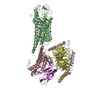 8j9nC  8j9oC 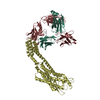 8jh7C 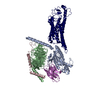 8jhbC 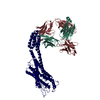 8jhcC M: map data used to model this data C: citing same article ( |
|---|---|
| Similar structure data | Similarity search - Function & homology  F&H Search F&H Search |
- Links
Links
- Assembly
Assembly
| Deposited unit | 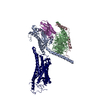
|
|---|---|
| 1 |
|
- Components
Components
| #1: Protein | Mass: 28861.875 Da / Num. of mol.: 1 / Mutation: G44D,E45N,A249D,S252D,I372A,V375I Source method: isolated from a genetically manipulated source Details: minGas / Source: (gene. exp.)   Homo sapiens (human) / Gene: GNAS, GNAS1 / Production host: Homo sapiens (human) / Gene: GNAS, GNAS1 / Production host:   Escherichia coli (E. coli) / References: UniProt: Q5JWF2 Escherichia coli (E. coli) / References: UniProt: Q5JWF2 |
|---|---|
| #2: Protein | Mass: 37069.543 Da / Num. of mol.: 1 Source method: isolated from a genetically manipulated source Source: (gene. exp.)   Homo sapiens (human) / Gene: GNB1 / Cell line (production host): Hi5 / Production host: Homo sapiens (human) / Gene: GNB1 / Cell line (production host): Hi5 / Production host:   Trichoplusia ni (cabbage looper) / References: UniProt: P62873 Trichoplusia ni (cabbage looper) / References: UniProt: P62873 |
| #3: Protein | Mass: 6261.229 Da / Num. of mol.: 1 Source method: isolated from a genetically manipulated source Source: (gene. exp.)   Homo sapiens (human) / Gene: GNG2 / Cell line (production host): Hi5 / Production host: Homo sapiens (human) / Gene: GNG2 / Cell line (production host): Hi5 / Production host:   Trichoplusia ni (cabbage looper) / References: UniProt: P59768 Trichoplusia ni (cabbage looper) / References: UniProt: P59768 |
| #4: Protein | Mass: 13711.284 Da / Num. of mol.: 1 Source method: isolated from a genetically manipulated source Source: (gene. exp.)   Homo sapiens (human) / Production host: Homo sapiens (human) / Production host:   Escherichia coli (E. coli) Escherichia coli (E. coli) |
| #5: Protein |  Mass: 60076.348 Da / Num. of mol.: 1 Source method: isolated from a genetically manipulated source Source: (gene. exp.)   Homo sapiens (human) / Gene: FZD3 / Cell line (production host): Sf9 / Production host: Homo sapiens (human) / Gene: FZD3 / Cell line (production host): Sf9 / Production host:   Spodoptera frugiperda (fall armyworm) / References: UniProt: Q9NPG1 Spodoptera frugiperda (fall armyworm) / References: UniProt: Q9NPG1 |
-Experimental details
-Experiment
| Experiment | Method:  ELECTRON MICROSCOPY ELECTRON MICROSCOPY |
|---|---|
| EM experiment | Aggregation state: PARTICLE / 3D reconstruction method:  single particle reconstruction single particle reconstruction |
- Sample preparation
Sample preparation
| Component | Name: Complex of FZD3-Gs heterotrimer with Nb35. / Type: COMPLEX / Entity ID: all / Source: RECOMBINANT | ||||||||||||||||
|---|---|---|---|---|---|---|---|---|---|---|---|---|---|---|---|---|---|
| Source (natural) | Organism:   Homo sapiens (human) Homo sapiens (human) | ||||||||||||||||
| Source (recombinant) |
| ||||||||||||||||
| Buffer solution | pH: 7.4 | ||||||||||||||||
| Specimen | Embedding applied: NO / Shadowing applied: NO / Staining applied : NO / Vitrification applied : NO / Vitrification applied : YES : YES | ||||||||||||||||
Vitrification | Cryogen name: ETHANE |
- Electron microscopy imaging
Electron microscopy imaging
| Experimental equipment |  Model: Titan Krios / Image courtesy: FEI Company |
|---|---|
| Microscopy | Model: FEI TITAN KRIOS |
| Electron gun | Electron source : :  FIELD EMISSION GUN / Accelerating voltage: 300 kV / Illumination mode: OTHER FIELD EMISSION GUN / Accelerating voltage: 300 kV / Illumination mode: OTHER |
| Electron lens | Mode: DIFFRACTION / Nominal defocus max: 2200 nm / Nominal defocus min: 1200 nm / Nominal defocus max: 2200 nm / Nominal defocus min: 1200 nm |
| Image recording | Electron dose: 20 e/Å2 / Film or detector model: GATAN K3 (6k x 4k) |
- Processing
Processing
CTF correction | Type: PHASE FLIPPING AND AMPLITUDE CORRECTION | ||||||||||||||||||||||||
|---|---|---|---|---|---|---|---|---|---|---|---|---|---|---|---|---|---|---|---|---|---|---|---|---|---|
3D reconstruction | Resolution: 3.2 Å / Resolution method: FSC 0.143 CUT-OFF / Num. of particles: 141786 / Symmetry type: POINT | ||||||||||||||||||||||||
| Refine LS restraints |
|
 Movie
Movie Controller
Controller








 PDBj
PDBj





















